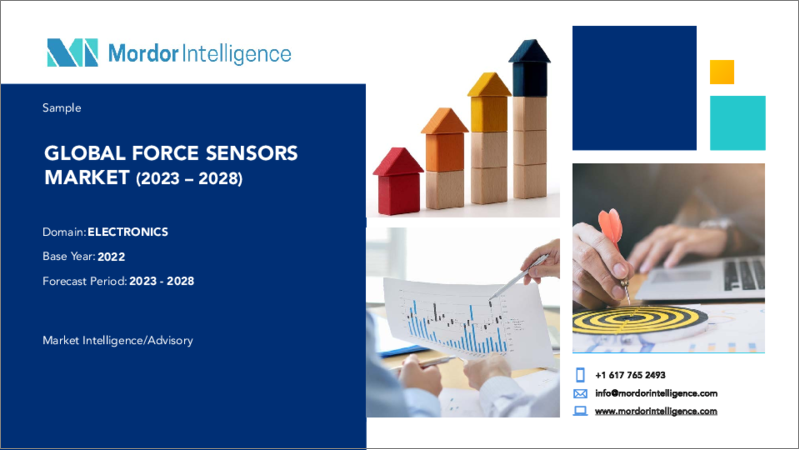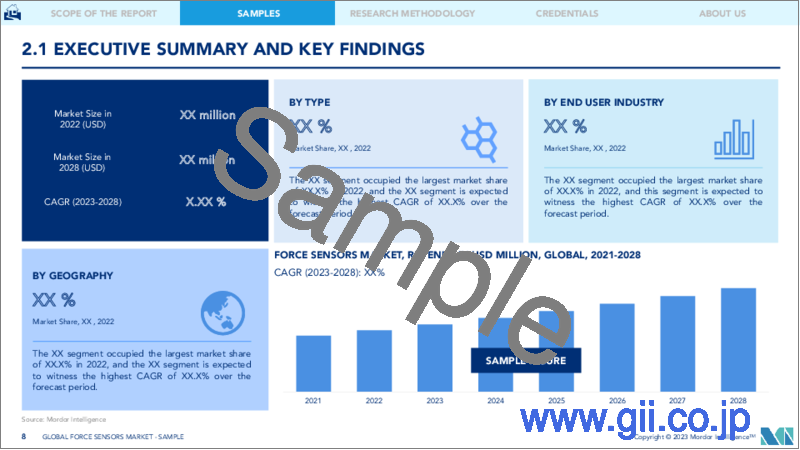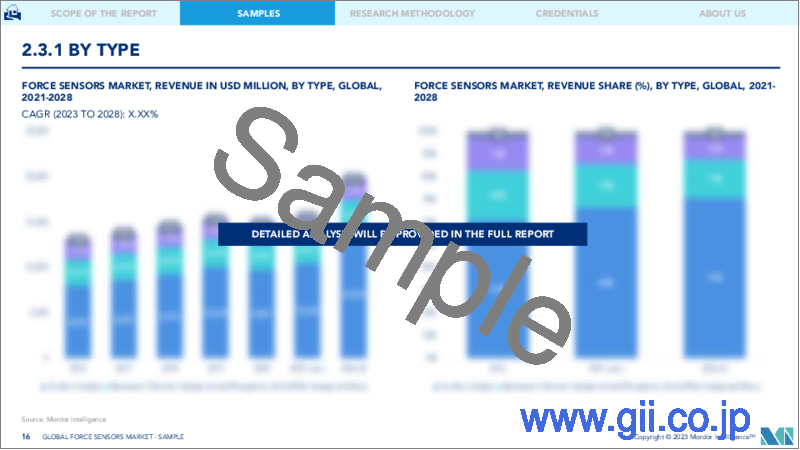|
|
市場調査レポート
商品コード
1190943
力センサー市場- 成長、動向、予測(2023年~2028年)Force Sensors Market - Growth, Trends, and Forecasts (2023 - 2028) |
||||||
|
● お客様のご希望に応じて、既存データの加工や未掲載情報(例:国別セグメント)の追加などの対応が可能です。 詳細はお問い合わせください。 |
|||||||
| 力センサー市場- 成長、動向、予測(2023年~2028年) |
|
出版日: 2023年01月18日
発行: Mordor Intelligence
ページ情報: 英文 120 Pages
納期: 2~3営業日
|
- 全表示
- 概要
- 目次
力センサー市場は、予測期間中にCAGR4.7%で成長すると予想されています。
力センサーは、産業用ロボットがタスクにとらわれず、人間と一緒に安全に操作できるようにすることで、産業用ロボットの重要な機能となっています。これらのセンサは、ネットワーク化された組み込みシステムの監視と管理を向上させました。自動化の導入により、これらのセンサはすべての自動化装置に不可欠なものとなり、すべての操作において正確さと精密さを提供するようになり、世界の情勢は一変しました。
主なハイライト
- フォースセンシングは表面をより直感的にし、ディスプレイはユーザーエクスペリエンスデザイナーが多くの家電製品の制御表面のレイアウトを簡素化し改善することを可能にします。新世代の家電製品のユーザーインターフェースを模索することで、デザイナーが新しいデザインに力センサーをシームレスに統合することが可能になりました。
- 力センサーは、車軸ビームやダンパーなどの車両部品が受ける力を追跡して疲労破壊を回避するために頻繁に設置されます。特に建設トラックや採掘車などの大型自動車では、過負荷や予期せぬストレスレベルがメンテナンスコストの上昇につながる可能性があるため、このようなセンサーが使用されます。
- さらに、安全規制の強化や、複数のパラメータに基づいて促進要因に警告を発するADAS(先進運転支援システム)の採用が急速に進んでいることも、予測期間中の力センサーの需要を押し上げると予想されます。
- さらに、産業用ロボットは、より適応性が高く、インテリジェントで、自律的です。力センサーの技術開発は、ロボットの進化を後押ししています。力センサーは、ロボットの手首やアーム先端の工具にかかるさまざまな力を検出することができます。力センサーの市場は、安価な生産コスト、技術の進歩、産業用ロボット需要の増加、力を計測する医療機器の誕生、産業分野での拡大・革新により拡大しています。
- また、パンデミック後に政府が規制を解除したことにより、自動車、家電、ヘルスケア産業からの需要が増加し、自動車や家電の消費者からの需要が増加し、さらに力センサー市場の成長に拍車をかけると予想されます。COVID-19のパンデミック後、世界の力センサー市場は、電気自動車、自律走行車、スマートフォン、スマートヘルスケア機器などの様々なアプリケーションへの需要により、安定した成長を見せました。このようなアプリケーションは、近い将来、市場を押し上げるでしょう。
- 現在の市場の力センサー製品ポートフォリオは、比較的標準化された製品提供となっています。市場は多くのアプリケーションに対応できる可能性を持っていますが、市場プレイヤーの提供する製品はかなり限定的です。しかし、OEMのニーズに合わせてカスタマイズされた力センサー製品のイントロダクションが見られるようになってきています。
- しかし、市場の重要な抑制要因は、エンドユーザー業界の需要が変動することです。エンドユーザー分野ではニーズが固定されておらず、生産スケジュールへの課題となっています。製造施設での不合格率は、損傷や感度の悪さによるもので、全体の生産能力を低下させます。さらに、自動車、医療、航空宇宙分野の要件が急速に変化していることも、より正確な測定の必要性を高めています。
主な市場動向
自動車産業が大幅な成長を遂げる見込み
- 自動車販売台数の増加と世界の自動車生産台数の増加により、ビジネスチャンスが生まれると期待されています。OICA(Organisation Internationale des Constructeurs Automobiles)によると、2021年の中国の自動車販売台数は2608万台と最高を記録しました。2021年には、自動車、商用車を含む約8,014万台の自動車が世界で生産されました。
- さらに、力センサーは自動車分野で一般的に採用されており、促進要因の安全性を高めるために操縦中の求心力を検出します。また、エンジン管理システム(MAP/BAP)や油圧モニタリングにも使用されています。これらの利点から、自動車産業におけるフォースセンサの需要は今後数年で拡大する可能性があります。
- 自動車産業は、インフォテインメントシステムの研究開発において、フォースセンサの新しい可能性を多く持っています。近年、自動車産業はタッチスクリーンユニットの優れた需要源として台頭してきました。Bosch、Denso、Infineon Technologiesなどの著名な自動車用センサメーカーは、さまざまな自動車アプリケーション向けに、技術的に高度で安全性の高いセンサベースの製品に投資しています。
- さらに、自動車分野では、促進要因の安全確保、エンジン管理システム、油圧システムなどに力センサーが使用されており、技術的に洗練された機能に対する需要が高まっていることから、将来的に力センサーの需要が増加すると予想されています。さらに、ロボティクスの普及とIIoTの進歩が市場を推進すると考えられます。
- さらに、安全規制の強化や、複数のパラメータに基づいて促進要因に警告を発する先進運転支援システム(ADAS)の導入が急速に進んでいることも、予測期間中の力センサーの需要を押し上げると予想されます。
- しかし、中国は原材料や完成品の主要サプライヤーの1つであるため、自動車産業はCOVID-19の発生によって影響を受けています。この分野では、生産量の減少、サプライチェーンの混乱、価格変動に直面しました。著名なエレクトロニクス企業の売上は影響を受けましたが、すぐに成長すると予想されます。
アジア太平洋が著しい成長を遂げる
- AIとIoT技術の成長とアジア太平洋地域の高い需要が、力センサー市場の成長を牽引し続けています。インド、中国などの新興諸国における技術の進歩と自動車基準の向上は、運用効率、信頼性、有効性の最大化などの複数の利点により、製造分野におけるセンサの需要増に影響を与えています。
- また、この地域は最も収益性の高い市場の1つです。工業用製造業が盛んで、力センサーを搭載したデバイスを利用する製品の国内消費量が多いことから、力センサーの優先順位が高くなっています。
- また、インドでは自動車産業が増加しており、世界の自動車市場においてますます重要な役割を担っています。例えば、IBEFによると、インドの乗用車市場は2021年に327億米ドルとなり、5年後には548億4,000万米ドルに達すると予想されています。さらに、インドの電気自動車(EV)市場は、2025年までに50,000カロールインドルピー(70億9,000万米ドル)に達すると予測されています。さらに、NITI AayogとRocky Mountain Institute(RMI)によると、インドのEV金融産業は2030年までに37,000万インドルピー(370万米ドル)に達する可能性があるとのことです。また、インドのEV市場は2026年までにCAGR36%で増加すると予測されています。これらの要因により、アジアの新興国における力センサーの市場は拡大することが予想されます。
- また、日本政府は2050年までに国内で販売される新車をすべて電気自動車またはハイブリッド車にすることを目標としています。同国は、電気自動車用のバッテリーやモーターの民間開発を加速させるため、補助金を提供する計画です。さらに、自律走行車の配備を促進するための投資の増加が、力センサーの成長見通しを後押しすると予想されます。
- このような楽観的な地域開拓は、予測期間中の市場成長を後押しすると予想されます。力センサーの市場を牽引する可能性が高いと予想されます。
競合情勢
力センサー市場は、Sensata Technologies、Alps Electric、Synaptics Inc.、Interlink Electronics Inc.、Pressure Profile Systems Inc.、Uneo Inc.などの少数の大手企業で構成され、かなり競争が激しいため、適度に断片化されています。
- 2022年10月-Sensata Technologiesは、電気機械式ブレーキ(EMB)用の新しいブレーキペダルフォースセンサを発表し、より安全で性能の良いブレーキシステムを可能にします。センサタのマイクロストレインゲージ・ブレーキペダルフォースセンサは、ブレーキの未来をサポートします。このセンサを導入することで、既存の技術に比べて車両の停止距離を短縮することができます。促進要因のブレーキ操作の意図を正確かつ迅速に把握することで、ブレーキングを改善します。
- 2022年10月Forsentek Co.Ltd.は、先進的なロードセル、力センサー、各種測定器を発売しました。これらは、最高の機能を発揮するために高品質の部品で設計されています。お客様は、高度な機能で設計された多軸力センサーを入手することもできます。これらのセンサーは、彼らが高い衝撃に耐え、効果的に働き続けることができることを保証するために、高い抵抗レベルで設計されています。
その他の特典
- エクセル形式の市場予測(ME)シート
- 3ヶ月間のアナリストサポート
目次
第1章 イントロダクション
- 調査の前提条件と市場の定義
- 調査対象範囲
第2章 調査手法
第3章 エグゼクティブサマリー
第4章 市場力学
- 市場概要
- 市場促進要因
- コンシューマーエレクトロニクス分野における技術革新と開発
- 自動車分野での需要急増
- 市場抑制要因
- 市場要求の変動とカスタマイズの問題
- バリューチェーン/サプライチェーン分析
- 産業の魅力- ポーターのファイブフォース分析
- 新規参入業者の脅威
- 買い手の交渉力
- 供給企業の交渉力
- 代替品の脅威
- 競争企業間の敵対関係
- COVID-19の業界への影響度評価
第5章 市場セグメンテーション
- タイプ
- 引張力センサー
- 圧縮力センサー
- 引張・圧縮力センサー
- エンドユーザー産業
- ヘルスケア
- 製造業
- 自動車
- 航空宇宙・防衛
- コンシューマーエレクトロニクス
- その他のエンドユーザー産業
- 地域別
- 北米
- 欧州
- アジア太平洋地域
- ラテンアメリカ
- 中東とアフリカ
第6章 競合情勢
- 企業プロファイル
- Alps Electric Co. Ltd
- Synaptics Inc.
- Interlink Electronics Inc.
- Pressure Profile Systems Inc.
- Uneo Inc.
- Futek Advanced Sensor Technology Inc.
- Tekscan Inc.
- Hottinger Baldwin Messtechnik(HBM)GmbH
- Kavlico Corporation
- Flintec Group AB
- Tecsis GmbH
- Shenzhen New Degree Technology Co. Ltd
- Sensel Inc.
- Tangio Printed Electronics
- NextInput Inc.
第7章 投資分析
第8章 市場機会と将来動向
The force sensors market is expected to register a CAGR of 4.7% over the forecast period. Force sensors have become critical features in industrial robots by enabling them to be task agnostic and safely operate alongside humans. These sensors have improved the monitoring and management of networked embedded systems. The adoption of automation has transformed the global landscape, as these sensors have become critical to all automated equipment, offering accuracy and precision in all operations.
Key Highlights
- Force sensing makes surfaces more intuitive, and the displays enable user experience designers to simplify and improve the control surface layouts on many appliances. It has allowed designers to seamlessly integrate force sensors into new designs by exploring a new generation of appliance user interfaces.
- Force sensors are frequently installed to track the force experienced by vehicle parts such as axle beams and dampers to avoid fatigue failure, particularly in heavy automotive vehicles such as construction trucks and mining vehicles, where overloading or unexpected stress levels may result in higher maintenance costs.
- Furthermore, the increasing safety regulations and rapidly rising adoption of advanced driver assistance systems (ADAS), which alert drivers based on several parameters, are expected to drive the demand for force sensors over the forecast period.
- Moreover, industrial robots are more adaptable, intelligent, and autonomous. The development of force sensor technologies is driving the advancement of robots. Force sensors can detect different forces when applied to the robot's wrist or end-of-arm tooling. The market for force sensors is expanding due to cheap production costs, technical advancements, rising industrial robot demand, the creation of force-measuring medical devices, and expansion and innovation in the industrial sector.
- Additionally, the demand from automotive, consumer electronics, and healthcare industries has increased post-pandemic situation as the government released the restriction and increased demand from the consumer for automotive and consumer electronics, which will further be expected to add growth for the force sensor market. After the COVID-19 pandemic, the global force sensor market showed steady growth due to its demand for various applications such as electric vehicles, autonomous vehicles, smartphones, and smart healthcare devices. Such applications will boost the market in the near future.
- The market's current force sensor product portfolio is relatively standardized in product offerings. Although the market has the potential to cater to a plethora of applications, the offerings of the market players are pretty limited. However, the market is witnessing the introduction of customized force sensor products for specific original equipment manufacturing (OEM) needs.
- However, the significant restraint in the market is the fluctuating demands of the end-user industry. Need is not fixed in the end-user sector and is a challenge to production schedules. Rejection rates at manufacturing facilities are due to damage or poor sensitivity, reducing overall production capacity. Additionally, rapidly changing requirements in the automotive, medical, and aerospace sectors drive the need for more accurate measurements.
Key Market Trends
Automotive Sector is Expected to Register a Significant Growth
- The rising automotive sales and increasing production of vehicles globally are expected to create opportunities. According to the OICA (Organisation Internationale des Constructeurs Automobiles), the sales of automobiles in China in 2021 reached the highest at 26.08 million units. In 2021, around 80.14 million motor vehicles, including cars, and commercial vehicles, were produced globally.
- Furthermore, force sensors are commonly employed in the automotive sector to detect centripetal force during maneuvers to increase driver safety. They are also used in engine management systems (MAP/BAP) and oil pressure monitoring. Because of these advantages, the demand for force sensors in the automobile industry may expand in the coming years.
- The automotive industry has many new opportunities for force sensors in the Research and development of infotainment systems. In recent years, the automotive industry has emerged as an excellent source of demand for touchscreen units. Prominent automotive sensor manufacturers like Bosch, Denso, and Infineon Technologies are investing in technologically advanced, safer, and more secure sensor-based products for various automotive applications.
- Moreover, the increasing demand for technologically sophisticated functionalities in the automotive sector, where force sensors are used for driver safety, engine management systems, and oil pressure systems, is expected to increase demand for force sensors in the future years. Furthermore, the growing popularity of robotics and advancements in IIoT will propel the market.
- Additionally, the increasing safety regulations and rapidly rising adoption of advanced driver assistance systems (ADAS), which alert the driver based on several parameters, are expected to drive the demand for force sensors over the forecast period.
- However, the automotive industry has been impacted by the COVID-19 outbreak, as China is one of the major suppliers of raw materials and finished products. The sector faced a reduction in production, disruption in the supply chain, and price fluctuations. The prominent electronic companies' sales were affected but are expected to grow soon.
Asia-Pacific to Witness the Significant Growth
- Growing AI and IoT technologies and high demand from the Asian-Pacific region continue to drive the force sensor market growth. Technological advances and rising automotive standards in developing countries such as India, China, and others are impacting the increasing demand for sensors in the manufacturing sector due to multiple benefits, including maximizing operational efficiency, reliability, and effectiveness.
- The region is also one of the most lucrative markets. It is becoming a priority for force sensors due to its prosperous industrial manufacturing industry and high domestic consumption of products that utilize devices with force sensors.
- The automotive industry has also been increasing in India, playing an increasingly important role in the global automotive market. For instance, according to IBEF, the Indian passenger car market was valued at USD 32.7 billion in 2021, and it is expected to reach USD 54.84 billion after five years. Additionally, India's electric vehicle (EV) market is projected to reach INR 50,000 crores (USD 7.09 billion) by 2025. Moreover, according to NITI Aayog and Rocky Mountain Institute (RMI), India's EV financial industry could reach INR 37 lakh (USD 3.7 million) by 2030. India's EV market is predicted to increase at a CAGR of 36% by 2026. These factors will drive the market for force sensors in developing Asian countries.
- Moreover, the Japanese government aims to have all new cars sold in Japan electric or hybrid by 2050. The country plans to offer subsidies to accelerate the private sector development of batteries and motors for electricity-powered cars. Besides, the increasing investments to encourage the deployment of autonomous vehicles are expected to drive the growth prospect for force sensors.
- Such optimistic regional developments are expected to boost market growth during the forecast period. It is expected to drive the market for force sensors likely.
Competitive Landscape
The force sensors market is moderately fragmented as the market is quite competitive and consists of a few major players, such as Sensata Technologies, Alps Electric Co. Ltd, Synaptics Inc., Interlink Electronics Inc., Pressure Profile Systems Inc., and Uneo Inc.
- October 2022 - Sensata Technologies announced its new Brake Pedal Force Sensor for electromechanical brakes (EMBs), enabling safer and better-performing braking systems. Sensata's micro strain gauge Brake Pedal Force sensor supports the future of braking. Implementing this sensor reduces a vehicle's stopping distance compared to existing technologies. It improves braking by accurately and rapidly capturing a driver's braking intent.
- October 2022 - Forsentek Co. Limited released advanced load cells, force sensors, and various measuring instruments. These are designed with high-quality components to ensure they function at their best. Clients can also get a multi-axis force sensor designed with advanced functionality. These sensors are designed with a high resistance level to ensure they can withstand high impacts and keep working effectively.
Additional Benefits:
- The market estimate (ME) sheet in Excel format
- 3 months of analyst support
TABLE OF CONTENTS
1 INTRODUCTION
- 1.1 Study Assumptions and Market Definitions
- 1.2 Scope of the Study
2 RESEARCH METHODOLOGY
3 EXECUTIVE SUMMARY
4 MARKET DYNAMICS
- 4.1 Market Overview
- 4.2 Market Drivers
- 4.2.1 Innovation and Development in the Consumer Electronics Sector
- 4.2.2 Surging Demand in the Automotive Sector
- 4.3 Market Restraints
- 4.3.1 Fluctuating Market Demands and Customization Issues
- 4.4 Value Chain/Supply Chain Analysis
- 4.5 Industry Attractiveness - Porter's Five Forces Analysis
- 4.5.1 Threat of New Entrants
- 4.5.2 Bargaining Power of Buyers
- 4.5.3 Bargaining Power of Suppliers
- 4.5.4 Threat of Substitute Products
- 4.5.5 Intensity of Competitive Rivalry
- 4.6 Assessment of COVID-19 Impact on the Industry
5 MARKET SEGMENTATION
- 5.1 Type
- 5.1.1 Tension Force Sensors
- 5.1.2 Compression Force Sensors
- 5.1.3 Tension and Compression Force Sensors
- 5.2 End-user Industry
- 5.2.1 Healthcare
- 5.2.2 Industrial Manufacturing
- 5.2.3 Automotive
- 5.2.4 Aerospace and Defense
- 5.2.5 Consumer Electronics
- 5.2.6 Other End-user Industries
- 5.3 Geography
- 5.3.1 North America
- 5.3.2 Europe
- 5.3.3 Asia-Pacific
- 5.3.4 Latin America
- 5.3.5 Middle East and Africa
6 COMPETITIVE LANDSCAPE
- 6.1 Company Profiles
- 6.1.1 Alps Electric Co. Ltd
- 6.1.2 Synaptics Inc.
- 6.1.3 Interlink Electronics Inc.
- 6.1.4 Pressure Profile Systems Inc.
- 6.1.5 Uneo Inc.
- 6.1.6 Futek Advanced Sensor Technology Inc.
- 6.1.7 Tekscan Inc.
- 6.1.8 Hottinger Baldwin Messtechnik (HBM) GmbH
- 6.1.9 Kavlico Corporation
- 6.1.10 Flintec Group AB
- 6.1.11 Tecsis GmbH
- 6.1.12 Shenzhen New Degree Technology Co. Ltd
- 6.1.13 Sensel Inc.
- 6.1.14 Tangio Printed Electronics
- 6.1.15 NextInput Inc.




